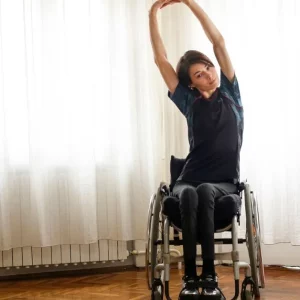Spinal cord injury can cause serious problems with blood circulation. As a result, cold feet is one of the most common symptoms of poor circulation that SCI patients experience.
You’re about to learn why you might have cold feet after spinal cord injury. Then, we will discuss what steps you can take to improve your circulation.
Why Circulatory Problems Cause Cold Feet After Spinal Cord Injury
The autonomic nervous system is responsible for controlling involuntary functions like blood pressure, heart rate, and other circulatory functions. This system is regulated by signals sent from the brain through the spinal cord.
When the spinal cord is injured, the brain can no longer communicate with the cardiac nerves. This causes the heart to either beat slowly or erratically. The reflexes that cause blood vessels to constrict or dilate may also be lost.
All of this changes the way that blood circulates throughout the body. If the heart cannot pump blood forcefully enough, it will be more difficult for oxygenated blood to reach the body’s extremities, including the feet. When there is low blood circulation, the feet will become cold and swollen.
Other Causes of Cold Feet
Besides circulation problems, there may also be other reasons why your feet are always cold after spinal cord injury.
Temperature Dysregulation

Problems with temperature regulation occur in patients with cervical and high thoracic spinal cord injuries.
That’s because the body regulates temperature partly through signals that pass through the spinal cord. For example, in a cold environment, the sensory nerves on your skin send messages to the brain to tell it that the body is getting cold. The brain then constricts blood vessels to prevent hypothermia.
However, if you have no sensation in your legs, your body cannot send these signals properly, and your brain cannot do anything to help keep your feet warm.
Lack of Movement
Lack of movement can also cause your feet to become cold after a spinal cord injury.
When a person walks, the muscles on their legs push against the blood vessels, which helps push the blood back up to the heart. This helps boost circulation, which keeps the legs and feet warm.
In addition, nearly 85% of body heat is generated by muscle contractions. Therefore, if your leg muscles cannot move, your body cannot produce enough heat on its own, and your feet will quickly become cold.
Limited mobility can also cause fluids to pool in lower extremities, which causes edema (swelling). Edema and cold feet tend to occur together.
Managing Cold Feet After Spinal Cord Injury
Fortunately, there are some effective ways to increase circulation in your feet, even though you can’t move them on your own.
The following are a few methods you can use to manage cold feet after spinal cord injury.
1. Passive or Active Exercise

If your legs are completely paralyzed or severely weak, passive range of motion exercises are an excellent way to improve circulation in your legs.
If you still have enough upper body function, you can use your arms to move your legs. If you have trouble reaching your legs, you can use a resistance band to help you lift them up.
Even if your upper body is paralyzed, have your caregiver or therapist move your legs for you. The more movement you can make, the more blood circulation you will have, which will warm up your cold feet.
For incomplete spinal cord injury patients who still have some degree of movement in the lower body, performing active exercises will help to stimulate the muscles and blood vessels to push blood back up towards the heart. These could be as simple as ankle pumps (pointing toes down then up), ankle rolls/circles, or knee lifts (trying to bend your knees up and down to the degree possible), all of which can be done when lying in bed.
2. Compression Stockings
Compression stockings gently squeeze your legs to help increase blood pressure. This can also help boost circulation.
However, sometimes compression stockings become too tight and can actually cut off circulation entirely, so talk to your doctor to check if these are safe for you.
Make sure you regularly check your skin for redness and skin breakdown, as these are signs that your stockings are too tight.
3. Heated Blanket and Warm Socks

Heated blankets and warm socks are essential for spinal cord injury patients, especially if you are in a colder climate.
Because of their diminished sensation, SCI patients are much more vulnerable to hypothermia in their feet. The effects of hypothermia can be dangerous and in severe cases can cause gangrene.
Therefore, even if the temperature outside is not below freezing, spinal cord patients should bundle their feet up and take precautions.
4. Leg Massage
Finally, massaging your legs a few times a day can stimulate better circulation. The increased blood flow raises the temperature of the surrounding muscles, including the muscles in your cold feet.
The pressure from the massage also increases blood pressure and reduces swelling.
Always massage your legs in an upward motion to help direct blood flow back to your heart.
Dealing With Cold Feet After Spinal Cord Injury: Key Points
Cold and swollen feet are common problems after a spinal cord injury. These issues are caused by a combination of poor blood circulation and physical inactivity.
Fortunately, passive range of motion exercises and leg massages can boost circulation, which will help warm your feet up. When you are not doing those activities, you can use compression socks and heated blankets to keep your feet from getting too cold again.
We hope this article has given you a better understanding of the reasons your feet might be cold after spinal cord injury. Good luck!











